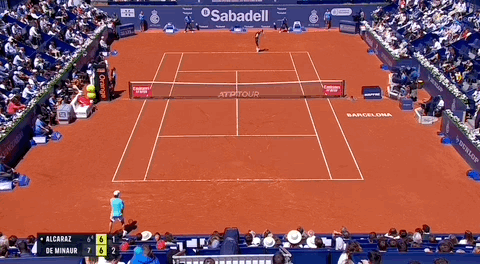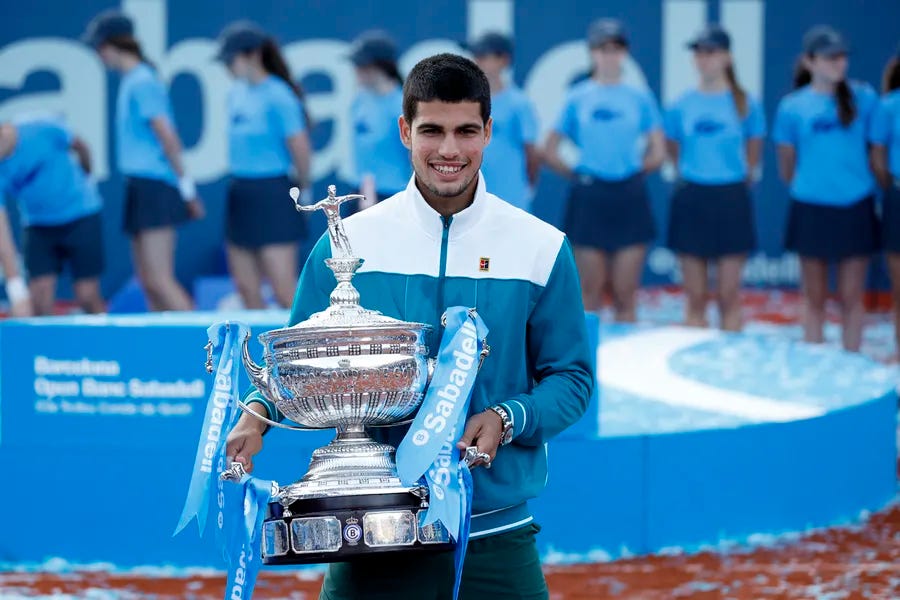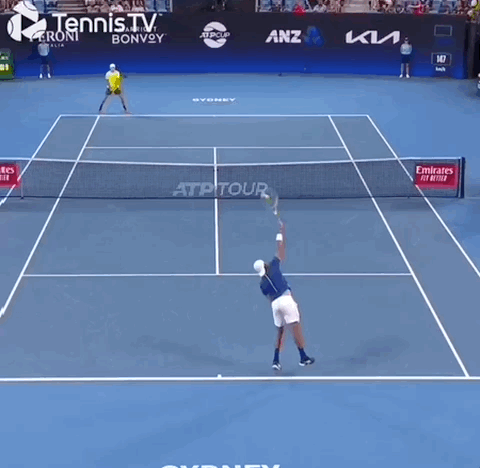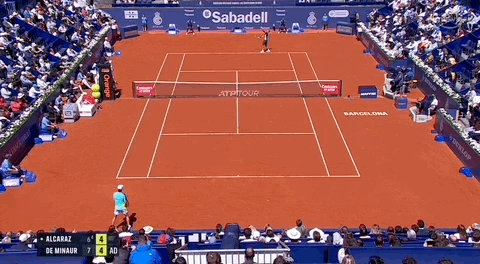Carlos Alcaraz wins the Barcelona Open: Close Call Analysis
Carlos Alcaraz won the Barcelona Open having survived a thriller against Alex De Minaur in the semifinal. We've analysed their battle to determine why it was such a tough match.
Last Sunday, Carlos Alcaraz defeated Pablo Carreno Busta to lift the Barcelona Open trophy.
It was a pretty underwhelming affair. PCB won only five games against his close compatriot, his forehand the only shot able to leave so much as a dent in the seemingly impenetrable armour of Alcaraz.
You wouldn’t have known it watching the final but, earlier that day, the 18-year-old had capped off the most impressive comeback of his career and the longest match in the history of the Barcelona Open1
Who was it that almost knocked tennis’s fastest rising star out of one of his home tournaments, that nearly shut the door on the Spaniard’s clay season, that held two match points at the tail end of the second set?
Of course! It was none other than Alex De Minaur, the flat-hitting Aussie with a 29% win-rate on clay coming into the tournament... Safe to say we didn't expect this to play out the way it did.
I’ll try and walk you through what the hell we witnessed on Saturday!
The De Minaur Return
De Minaur is a fantastic returner - yet he isn’t a particularly successful clay-courter. The numbers don’t make sense at first glance… until you take a closer look at De Minaur’s preferred style of return.
He is one of the few players with a return far more suited to hard-courts than clay-courts. De Minaur uses his exceptional hand-eye coordination, anticipatory skills and agility to block the return back into play, using the speed of the courts to help his return travel.
Notice De Minaur (top) is basically camped on the baseline against one of the game’s biggest servers (Matteo Berrettini in this GIF). The racket take-back is basically non-existent, the pace of the serve doing all the heavy lifting.
On a clay-court, De Minaur can’t really utilise this weapon.
The blocked-back return doesn’t travel as quickly as it would on a hard-court.
Spinny serves react to the clay making it much more difficult to take the ball early.
A couple of tweaks here and there however and De Minaur actually has the game to be an effective clay-courter.
Him and his coach, Adolfo Gutierrez, appear to have made progress on returning from deep in the court, using a touch more topspin to return effectively with depth. The hand-eye coordination and feel for the return are a foundation of De Minaur’s game - consequently, it's something he seems to have adapted to quickly.
Against Alcaraz, this was the go-to return strategy - not loading the ball with spin but returning from deep enough to get away with hitting with just enough topspin, aiming for within a few feet of the baseline.
De Minaur’s (bottom) return capability was a perfect antidote to the normally extremely potent Alcaraz (top) kicker out wide. Against Tsitsipas for example, Alcaraz would almost certainly have been up in the point off this serve; against De Minaur, the return is neutralised perfectly into the top corner, slowing down the following forehand and giving De Minaur a perfect opportunity to flatten down the line for a winner.
Exactly the same on a very important point. I’ve cut the GIF down but De Minaur (bottom) goes onto win the point after neutralising this incredibly strong Alcaraz (top) kicker.
Another important point where Alcaraz (bottom) is unable to attack using his inside-in forehand on the +1 shot so opts to hit neutrally back inside-out.
Without the kick-serve out wide advantage, Alcaraz won his second-lowest percentage of second-serve points for this year at 43.1%2.
Clearly many of Alcaraz’s serves were being neutralised but that was only half the battle.
De Minaur still had to find a way of winning points.
Alcaraz’s Linear Strikes
On the latest episode of the podcast, I recently joked about not being sure what surface Alcaraz was most comfortable on.
Besides a poor attempt at getting a giggle from the audience, one of the reasons I said that is because of the way in which Alcaraz prefers to construct a point.
On hard and clay, in a neutral rally, we often seen Alcaraz go for a linear pacey shot to push his opponent deep in the court and potentially draw a short ball before using a bit more nuance and angle (but still with plenty power) on the following one or two shots to put the point to bed.
This is actually a little unorthodox for clay - Rafa for example tends to play with a lot more angle to spread the court, essentially leaving his opponent for dead in the ad-court once he gets that first forehand cross-court.
Against most though, Alcaraz’s power tends to be overwhelming, regardless of the surface.
De Minaur is a different beast. Whilst he can't redirect serves in the way he'd prefer on clay, his speed and blocked-back shots allow him to redirect linear groundstrokes effectively, giving him an advantage against Alcaraz's incredibly powerful hits than many other players would not have had.
Alcaraz’s usual kicker plus huge forehand inside-in strategy was not a particularly effective play against the return depth and absorption abilities of a red-hot De Minaur, the Spaniard eventually failing to find the court time and time again in the longer rallies.
Just as well tennis’s new poster-boy isn’t a one-trick pony.
All-Court Alcaraz
When the going got tough and Alcaraz had to make a play, it was his much-revered variation that bailed him out of trouble.
The drop-shot wasn’t a staple of his game against De Minaur - the Aussie’s speed wouldn’t have allowed that shot to be played regularly - but Alcaraz was still able to pull off a few really clutch ones when De Minaur was least expecting it.


This and a few moves forward to capitalise on his haymakers made all the difference in important moments.

We’re still learning a lot about Alcaraz’s game - we’ve only scratched the surface of the Alcaraz drop-shot and volley game for example3 - but it’s clear early in his career he is comfortable using these weapons whatever the scenario.
In a battle where there really wasn’t anything in it trading groundstrokes, this is the only thing that set Alcaraz apart from De Minaur.
That Match Point Though?
Well… almost the only thing.
There was also THIS SHOT down match point.
Really interesting to read this discussion between two of my colleagues over at Popcorn Tennis…
It did get me thinking - did De Minaur make the right play?
Here’s my take. Down the middle was definitely not the right play here (probably loaded with nerves), not on a clay-court against one of the greatest movers we’ve seen in a while. You gotta go cross or inside-out on this ball - I actually don’t think inside-out was a much riskier play given the height and proximity to the net that De Minaur took the forehand from.
Maybe De Minaur was terrified of the Alcaraz backhand lob?
At the end of the day, I guess nobody could have predicted Alcaraz’s RIDICULOUS behind-the-back forehand clean passing winner inside-in.
As I say though, we’re still learning a lot about this guy including slowly piecing together just how high his peak is.
Congrats to both players on a fantastic match 👏
3 hrs 39 mins. It overtook last year’s final between Tsitsipas and Rafa (3 hrs 38 mins).
Alcaraz’s lowest second-serve won percentage this year was against Soon-woo Kwon earlier in the tournament where there was a significant dip in level in their second set. In the semifinal v De Minaur, Alcaraz’s level remained fairly steady throughout.
E.g. How far does it set him apart from his peers? How frequently will he look to use those shots on different surfaces? Does he actively look to use these shots under pressure (i.e. was the serve and drop-shot premeditated or instinctively felt against De Minaur in that second-set tiebreak)?









